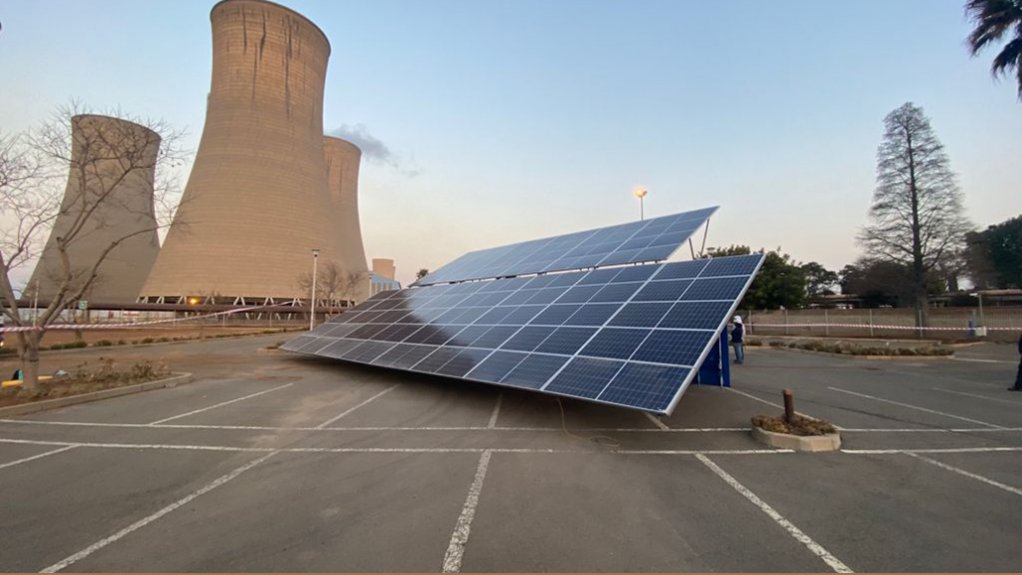German energy expert says energy transition a mistake
The energy transition in its current form, as a grid-scale build out of wind and solar with the goal to replace oil, coal and gas, is probably one of the greatest mistakes that humanity has ever made, German-listed commodity company HMS Bergbau Group shareholder Dr Lars Schernikau said at nonprofit organisation FFF Carbon’s 2024 Middelburg Coal Conference in Mpumalanga, on October 17.
“It's a very uncomfortable and unpopular thing to say,” he admitted, highlighting numerous often ignored challenges posed by the ongoing energy transition.
“This does not mean that every wind turbine and every solar panel is bad," Schernikau added, outlining several key issues with grid-scale wind and solar energy, starting with the problem of energy density.
“Even though wind energy and solar energy appears free and almost unlimited, whatever we get per square meter is very little,” he said, noting similarly that other future energy alternatives, such as liquid hydrogen – an energy carrier and not a source of energy – offer only a fraction of the energy density provided by petroleum, which would result in higher costs and a greater environmental impact.
Schernikau also addressed the underwhelming operational lifetimes of renewable-energy infrastructure, citing concerns over their longevity.
“Wind and solar power plants have a very limited operational lifetime. You have to replace them every few years. How many years? We don’t know. What we do know, is that it doesn’t last 25 years at grid scale,” he said.
Schernikau and other scientists are currently working on an academic study detailing this issue.
He noted that the newest grid-scale solar panels from China last between 12 to 15 years, a far cry from the 25 to 35 years often projected in net-zero analyses. He clarified that, while certain solar panels on residential rooftops might last 25 to 35 years, this longevity did not apply to grid-scale infrastructure owing to the optimisation of materials for cost-efficiency.
He pointed out that windmills, particularly offshore installations, often had operational lifespans of just 8 to 15 years owing to factors such as sea salt corrosion. He added that 'repowering' is another aspect that shortens the life of wind and solar installations.
Another major challenge Schernikau highlighted was the issue of intermittency. He pointed to studies carried out over three years, which showed that wind and solar were able to meet energy demands when demand was at an absolute minimum and generation was at an absolute maximum. However, it was far from capable of meeting peak energy demand at any stage.
This shortfall is compounded by the fact that electricity demand is projected to rise dramatically, driven by the increased use of electric vehicles, AI-enabled industrialisation, population increases and general per capita demand increases.
He quoted the International Energy Agency (IEA), which projects that peak power demand will increase more than 1.5 times in the next decade, particularly in Asia and other developing economies.
“This peak power demand increase is not by 2050. This is in ten years,” Schernikau warned, stressing that the world was not building enough peak power capable power plants to meet future power demand. His central argument was that new optimised coal-fired as well as gas-fired power plants are an important aspect for the way forward, not only more wind and solar.
He pointed to China and India as good examples, where both economies were investing in wind and solar alongside new investments in coal-fired power and clean coal technologies that will ensure enough energy supply to satiate peak power demand.
“Virtually every silicon smelter in China has a dedicated coal fired power station," Schernikau noted.
He further highlighted the hidden cost of solar systems from required overbuilding and ancillary systems such as storage, backup and transmission, along with end-of-life disposal and environmental issues.
In South Africa, for example, the natural solar capacity factor is 25%, meaning that energy production is significantly lower than total installed capacity.
“In South Africa, you would have to overbuild four times, assuming zero storage or ancillary systems” he said, adding that, in Germany, where the natural capacity factor is about 10%, the overbuild would need to be as much as ten times.
Compounding the problem, storing energy to shift it from daytime to nighttime use would result in significant losses, depending on the storage technology used. He noted that battery storage results in a about 20% energy loss from beginning to end, while hydrogen storage results in up to 80% loss.
In Germany, Schernikau calculated that the required overbuild could reach far more than 100 times to compensate for storage losses and to build up enough power for only ten days' storage using hydrogen as a proposed long duration storage solution.
He elaborated on the inherent limitations of 'technology as a fix', saying the energy density of wind and solar could not be improved by technology, neither can technology change the intermittency and thus unpredictability of wind and solar.
“I cannot change the sunshine. I cannot change the density per square meter. And those systems that include just a few days of storage must be overbuilt by more than 100 times and be renewed every 12 to 15 years. Is this the sustainable future of our energy systems?” he asked.
He also pointed out that, as systems were further optimised for cost, they became “thinner and more prone to failure”.
Another issue Schernikau highlighted was the increased need for input energy and raw materials in wind and solar based-energy systems. He referenced the IEA, confirming that a clean energy system required more resources, including silicon, aluminium, iron, steel, copper, rare earths and various chemicals, than fossil fuel-based energy systems.
Beyond the overbuild requirements, Schernikau stressed that renewable systems needed both short-duration storage, such as batteries, and long-duration storage, along with backup thermal power plants to ensure reliable energy supply. Germany plans to use hydrogen-powered thermal backup power stations.
This, combined with the need for new, larger, and more complex transmission grids and smart systems, significantly raises the cost, he pointed out.
“The required transmission infrastructure for wind and solar is probably up to twice as large and complex as normal transmission infrastructure using conventional power systems,” he added, underscoring the economic implications.
Despite the technological advancements in AI, Schernikau asserted that physics and the laws of thermodynamics remain a limiting factor.
“You cannot overcome the loss of thermodynamics. The more complex your energy system, the more energy you lose, thereby warming the biosphere from those energy losses," he explained, adding that renewable systems might paradoxically contribute to global warming owing to these inefficiencies, not to mention the albedo warming effects from their large area-covering installations.
Environmental concerns are also prevalent in wind and solar infrastructure. Schernikau warned of the challenges associated with the large-scale deployment of solar and wind systems, including their impact on land use, flora, and wildlife.
Additionally, the low recyclability of solar panels and other required components poses a significant disposal issue.
“Recycling again would require energy and raw materials for the installation and processes needed to perform it. So, in reality, unused older wind and solar installations just get thrown out, as it's far cheaper” he said.
Schernikau was bluntly pessimistic about the true financial viability of wind and solar energy on a grid scale.
“There is no way you can make honest money with wind and solar. It’s not possible. When I say honest money, I mean without somebody else’s money, because you are living off somebody’s subsidies, which is paid by taxpayers,” he said.
He illustrated this by pointing to the economic problems with high solar penetration in markets such as Germany, where an oversupply of solar energy has led to a significant drop in prices. In May, for example, the price of solar energy in Germany fell by 50%, reducing the earnings of solar producers. Negative power price days are at an all time high in Germany and other countries, Schernikau pointed out.
The impact of high electricity costs on households was another area of concern. Schernikau cited a March report from the German government auditor Bundesnetzagentur, which revealed that energy poverty in Germany had risen to 25%, meaning one in four households is now classified as energy poor.
“For these households, electricity has become so expensive that they cannot easily afford it,” he said, warning that this scenario could be exported to other regions, including Africa.
Schernikau argued that the transition to wind and solar on a country-wide scale was not a viable solution but a costly mistake that should be avoided. He conceded that off-grid solar systems could be beneficial, particularly in rural areas, but once integrated into a grid, they contributed to the overall system’s cost and inefficiency.
"Using solar to heat a pool, for example, is a great idea. However, the transition to wind and solar as a grid solution comes with a high cost and the impact is on the environment, on the economy, and, of course, on the people. It is not a transition or a solution. It’s rather becoming a big problem,” Schernikau asserted.
Instead of embracing wind and solar as an energy cure-all, Schernikau called for the development of an alternative energy solution with a 150-year lifespan. He said that such a solution would require a significant investment into research and development, adding that it was important to "urgently" invest in existing oil, gas, coal and nuclear energy systems to make them cleaner and more efficient so that growing electricity demand could be met globally.
"Let's wake up and deal with it and not run away from reality," Schernikau said.
Article Enquiry
Email Article
Save Article
Feedback
To advertise email advertising@creamermedia.co.za or click here
Announcements
What's On
Subscribe to improve your user experience...
Option 1 (equivalent of R125 a month):
Receive a weekly copy of Creamer Media's Engineering News & Mining Weekly magazine
(print copy for those in South Africa and e-magazine for those outside of South Africa)
Receive daily email newsletters
Access to full search results
Access archive of magazine back copies
Access to Projects in Progress
Access to ONE Research Report of your choice in PDF format
Option 2 (equivalent of R375 a month):
All benefits from Option 1
PLUS
Access to Creamer Media's Research Channel Africa for ALL Research Reports, in PDF format, on various industrial and mining sectors
including Electricity; Water; Energy Transition; Hydrogen; Roads, Rail and Ports; Coal; Gold; Platinum; Battery Metals; etc.
Already a subscriber?
Forgotten your password?
Receive weekly copy of Creamer Media's Engineering News & Mining Weekly magazine (print copy for those in South Africa and e-magazine for those outside of South Africa)
➕
Recieve daily email newsletters
➕
Access to full search results
➕
Access archive of magazine back copies
➕
Access to Projects in Progress
➕
Access to ONE Research Report of your choice in PDF format
RESEARCH CHANNEL AFRICA
R4500 (equivalent of R375 a month)
SUBSCRIBEAll benefits from Option 1
➕
Access to Creamer Media's Research Channel Africa for ALL Research Reports on various industrial and mining sectors, in PDF format, including on:
Electricity
➕
Water
➕
Energy Transition
➕
Hydrogen
➕
Roads, Rail and Ports
➕
Coal
➕
Gold
➕
Platinum
➕
Battery Metals
➕
etc.
Receive all benefits from Option 1 or Option 2 delivered to numerous people at your company
➕
Multiple User names and Passwords for simultaneous log-ins
➕
Intranet integration access to all in your organisation



















